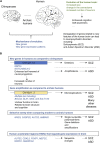Keeping the balance: Trade-offs between human brain evolution, autism, and schizophrenia
- PMID: 36479251
- PMCID: PMC9719942
- DOI: 10.3389/fgene.2022.1009390
Keeping the balance: Trade-offs between human brain evolution, autism, and schizophrenia
Abstract
The unique qualities of the human brain are a product of a complex evolutionary process. Evolution, famously described by François Jacob as a "tinkerer," builds upon existing genetic elements by modifying and repurposing them for new functions. Genetic changes in DNA may lead to the emergence of new genes or cause altered gene expression patterns. Both gene and regulatory element mutations may lead to new functions. Yet, this process may lead to side-effects. An evolutionary trade-off occurs when an otherwise beneficial change, which is important for evolutionary success and is under strong positive selection, concurrently results in a detrimental change in another trait. Pleiotropy occurs when a gene affects multiple traits. Antagonistic pleiotropy is a phenomenon whereby a genetic variant leads to an increase in fitness at one life-stage or in a specific environment, but simultaneously decreases fitness in another respect. Therefore, it is conceivable that the molecular underpinnings of evolution of highly complex traits, including brain size or cognitive ability, under certain conditions could result in deleterious effects, which would increase the susceptibility to psychiatric or neurodevelopmental diseases. Here, we discuss possible trade-offs and antagonistic pleiotropies between evolutionary change in a gene sequence, dosage or activity and the susceptibility of individuals to autism spectrum disorders and schizophrenia. We present current knowledge about genes and alterations in gene regulatory landscapes, which have likely played a role in establishing human-specific traits and have been implicated in those diseases.
Keywords: ASD; cognition; evolution; psychiatric discorders; schizophrenia.
Copyright © 2022 Duński and Pękowska.
Conflict of interest statement
The authors declare that the research was conducted in the absence of any commercial or financial relationships that could be construed as a potential conflict of interest.
Figures

Similar articles
-
Trade-Offs (and Constraints) in Organismal Biology.Physiol Biochem Zool. 2022 Jan-Feb;95(1):82-112. doi: 10.1086/717897. Physiol Biochem Zool. 2022. PMID: 34905443
-
Quantifying the strength of viral fitness trade-offs between hosts: a meta-analysis of pleiotropic fitness effects.Evol Lett. 2024 Jul 29;8(6):851-865. doi: 10.1093/evlett/qrae038. eCollection 2024 Dec. Evol Lett. 2024. PMID: 39677573 Free PMC article.
-
Sign epistasis limits evolutionary trade-offs at the confluence of single- and multi-carbon metabolism in Methylobacterium extorquens AM1.Evolution. 2014 Mar;68(3):760-71. doi: 10.1111/evo.12301. Epub 2013 Nov 20. Evolution. 2014. PMID: 24164359
-
Rational evolutionary design: the theory of in vitro protein evolution.Adv Protein Chem. 2000;55:79-160. doi: 10.1016/s0065-3233(01)55003-2. Adv Protein Chem. 2000. PMID: 11050933 Review.
-
Trade-offs, Pleiotropy, and Shared Molecular Pathways: A Unified View of Constraints on Adaptation.Integr Comp Biol. 2020 Aug 1;60(2):332-347. doi: 10.1093/icb/icaa056. Integr Comp Biol. 2020. PMID: 32483607 Review.
References
-
- Ardesch D. J., Scholtens L. H., Li L., Preuss T. M., Rilling J. K., van den Heuvel M. P. (2019). Evolutionary expansion of connectivity between multimodal association areas in the human brain compared with chimpanzees. Proc. Natl. Acad. Sci. U. S. A. 116, 7101–7106. 10.1073/pnas.1818512116 - DOI - PMC - PubMed
Publication types
LinkOut - more resources
Full Text Sources

